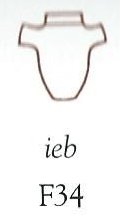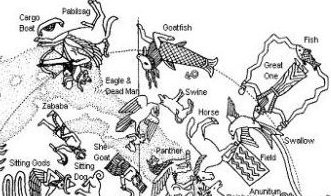After
the
'Land
Fish'
had
breen
brought
up
from
the
deeps
in
ºJune
30
(which
also
at
the
time
of
Gregory
XIII
was
the
true heliacal
day
for
Sirius
-
the
remarkable
star
which
went
in
the
same
path
as the
Sun),
I
think
it
was
due
for
the
twin
halfyears
beginning
at
07h
respectively
at
19h
to
enter
the
stage.
The
first
such
halfyear
was
perhaps
depicted
as a
rising
fish
and
the
latter
as a
descending
fish
(Ga2-13
respectively
Ga2-17):
 |
 |
 |
 |
| Ga2-5 |
Ga2-6 |
Ga2-7 |
Ga2-8 |
| APRIL 25 (*400) |
26 (*36) |
27 |
28 (118) |
| ν Puppis (99.2), ψ3 Aurigae (99.4), ψ2 Aurigae (99.5)
Gemma
|
ψ4 Aurigae (100.5), Mebsuta (100.7) |
TE POU (101.2), ψ5 Aurigae (101.4), ν Gemini (101.6), ψ6 Aurigae (101.7) |
τ Puppis (102.2), ψ7 Aurigae (102.4) |
| June 28 |
29 |
30 |
July 1 (182) |
| ST JOHN'S EVE |
ºJune 25 |
26 (177) |
27 |
| 'June 1 (*72) |
2 |
3 |
4 |
| "May 18 (*58) |
19 |
20 (140) |
21 |
| NAKSHATRA DATES: |
| OCTOBER 25 |
26 |
27 (300) |
28 (*221) |
| no star listed (282) |
ζ Pavonis (283.4), λ Cor. Austr. (283.6), Double Double (283.7), ζ Lyrae (283.8) |
South Dipper-8 |
Sheliak, ν Lyrae (285.1), λ Pavonis (285.7)
Atlas
|
| Φ SAGITTARII (284.0), μ Cor. Austr. (284.6), η Cor. Austr., θ Pavonis (284.8) |
| December 28 |
29 |
30 (364) |
31 |
| CHRISTMAS EVE |
ºDecember 25 |
26 (360) |
27 |
| 'December 1 |
2 |
3 (*257) |
4 |
| "November 17 |
18 |
19 |
20 (324) |
 |
 |
 |
 |
| Ga2-9 |
Ga2-10 (40) |
Ga2-11 |
Ga2-12 |
| APRIL 29 (*39) |
30 |
MAY 1 (121) |
2 (*407) |
| Mash-mashu-sha-Risū-10 |
Adara (104.8) |
ω Gemini (105.4), Alzirr (105.7), Muliphein (105.8), Mekbuda (105.9) |
7h (106.5) |
| θ Gemini (103.0), ψ8 Aurigae (103.2), Alhena (103.8), ψ9 Aurigae (103.9) |
no star listed (106) |
| July 2 |
3 |
4 (181 + 4) |
5 |
| ºJune 28 |
29 (*100) |
30 |
ºJuly 1 (182) |
| 'June 5 |
6 |
7 (*78) |
8 |
| "May 22 |
23 |
24 (144) |
25 (*65) |
| NAKSHATRA DATES: |
| OCTOBER 29 (*222) |
30 |
31 |
NOVEMBER 1 (305) |
| χ Oct. (286.0), Ain al Rami (286.2), δ Lyrae (286.3), κ Pavonis (286.5), Alya (286.6) |
ξ Sagittarii (287.1), ω Pavonis (287.3), ε Aquilae, ε Cor. Austr., Sulaphat (287.4), λ Lyrae (287.7), Ascella, Bered (Ant.) (287.9) |
Al Na'ām-18 / Uttara Ashadha-21 |
19h (289.2) |
| NUNKI (288.4), ζ Cor. Austr. (288.5), Manubrium (288.8), ζ Aquilae (288.9) |
λ Aquilae (Ant.) (289.1), γ Cor. Austr (289.3), τ Sagittarii (289.4), ι Lyrae (289.5), δ Cor. Austr. (289.8) |
| January 1 (366) |
2 |
3 |
4 |
| ºDecember 28 |
29 |
30 (364) |
31 (*285) |
| 'December 5 |
6 |
7 |
8 (342) |
| "November 21 (325) |
22 |
23 |
24 (*248) |
 |
 |
 |
 |
 |
| Ga2-13 |
Ga2-14 |
Ga2-15 |
Ga2-16 (46) |
Ga2-17 |
| MAY 3 (*408) |
4 |
5 (125) |
6 (*46) |
7 |
| Wezen (107.1), τ Gemini (107.7), δ Monocerotis (107.9) |
no star listed (108) |
λ Gemini (109.4), Wasat (109.8) |
no star listed (110) |
Aludra (111.1), Propus (111.4), Gomeisa (111.6) |
| July 6 (*107) |
7 (188) |
8 |
9 |
10 |
| ºJuly 2 |
3 |
4 (185) |
5 |
6 (*107) |
| 'June 9 |
10 |
11 |
12 |
13 (*84) |
| "May 26 |
27 |
28 (*68) |
29 |
30 (150) |
| NAKSHATRA DATES: |
| NOVEMBER 2 |
3 |
4 (*228) |
5 |
6 (310) |
| Al Baldah-19 |
Aladfar (291.1), Nodus II (291.5), ψ Sagittarii (291.6), θ Lyrae (291.8) |
ω Aquilae (292.1), ρ Sagittarii (292.6), υ Sagittarii (292.7) |
Arkab Prior (293.0), Arkab Posterior, Alrami (293.2), χ Sagittarii (293.6) |
Deneb Okab (294.0), α Vulpeculae (294.9) |
| AL BALDAH, Alphekka Meridiana (290.1), β Cor. Austr. (290.2) |
| January 5 |
6 |
7 (372) |
8 |
9 |
| ºJanuary 1 |
2 |
3 (*288) |
4 |
5 (370) |
| 'December 9 |
10 (344) |
11 (*265) |
12 |
LUCIA |
| "November 25 (329) |
26 (*250) |
27 |
28 |
29 |
...
Wezen (δ
at the
back
bone of
the
Great
Dog)
means
'weight'
and we
can
guess
the
position
of
Rogo
in
Gb6-26
indicated
a place
to be
determined
by a
line
with a
weight
(Latin
plumbum
= lead)
hanging
down.
...
δ,
2.2,
light
yellow,
is the
modern
Wezen,
from
Al Wezn,
Weight,
'as the
star
seems to
rise
with
difficulty
from the
horizon';
but
Ideler
calls
this an
astonishing
star
name
...


...
Wasat
('the
Middle',
δ
Gemini)
was
close to
the
ecliptic
and it
may have
represented
the
navel of
Pollux
...
 |
 |
 |
|
 |
 |
 |
| Ga2-18 |
Ga2-19 |
Ga2-20 (50) |
Ga2-21 |
Ga2-22 |
Ga2-23 |
| MAY 8 (*413) |
9 |
10 (130) |
11 |
12 |
13 (*53) |
| Ghost-23 |
Al Dhirā'-5 / Punarvasu-7 / Mash-mashu-Mahrū-11 |
ANA-TAHUA-VAHINE-O-TOA-TE-MANAVA |
α Monocerotis (115.4), σ Gemini (115.7) |
Mash-mashu-arkū-12 |
Azmidiske (117.4) |
| ρ GEMINI (112.1), Eskimo Nebula (112.2) Antares
|
CASTOR (113.4) |
υ Gemini (114.0), Markab Puppis (114.7), ο Gemini (114.8), PROCYON (114.9) |
κ Gemini (116.1), POLLUX (116.2), π Gemini (116.9) |
| July 11 |
12 (193) |
13 |
14 |
15 (196) |
16 |
| ºJuly 7 (*108) |
8 |
9 |
10 |
11 (384 / 2) |
12 |
| 'June 14 |
15 |
16 |
17 (*88) |
18 |
19 |
| "May 31 (151) |
"June 1 |
2 (*73) |
3 |
4 |
5 |
| NAKSHATRA DATES: |
| NOV 7 (*231) |
8 |
9 |
|
10 (314) |
11 |
12 |
| ν Aquilae (Ant.) (295.0), Albireo (295.5) |
μ Aquilae (296.3), ι Aquilae (Ant.) (296.8), κ Aquilae (Ant.) (296.9) |
ε Sagittae (297.1), σ Aquilae (Ant.) (297.4), Sham (297.8) |
β Sagittae (298.0), χ Aquilae (298.3), ψ Aquilae (298.8) |
υ Aquilae (299.1), Tarazed (299.3), δ Sagittae (299.6), π Aquilae (299.9) |
Sravana-23 |
| ζ Sagittae (300.1), ALTAIR (300.3), ο Aquilae (300.5), Bezek (300.8) |
| January 10 |
11 |
12 (377) |
13 |
14 |
15 |
| ºJanuary 6 |
7 (372) |
8 |
9 |
10 (*295) |
11 |
| 'December 14 |
15 |
16 (350) |
17 |
18 |
19 |
| "November 30 |
"December 1 |
2 (336) |
3 |
4 |
5 (*259) |
The
Eastern
One
of
the
Twins
(Mash-mashu-arkū)
was
Pollux,
at
their
12th
station,
whereas
Castor
was
at
the
preceding
station
in
the
west
(Mash-mashu-Mahrū).
This
may
at
first appear
strange,
because
both
the stars
and
the
Sun
are
rising
in
the
east
and
descending
in
the
west.
However,
Castor
was
the
mortal
one
and
he
should
therefore
die
in
the
west,
although
like
the
Dead
Man
to
be
brought
across
to
next
spring:

ºJuly
11
was
day
192
(=
384
/
2).
In
the
nakshatra
night
was
the
Eagle,
close
to
the
Full
Moon
295
nights
after
0h:

...
When
Castor
was
killed,
Pollux
asked
Zeus
to
let
him
share
his
own
immortality
with
his
twin
to
keep
them
together,
and
they
were
transformed
into
the
constellation
Gemini.
The
pair
were
regarded
as
the
patrons
of
sailors,
to
whom
they
appeared
as
St.
Elmo's
fire,
and
were
also
associated
with
horsemanship
...
...
Gemini
represents
the
twins
Castor
and
Polydeuces
(Pollux
is
the
Latin
form
of
his
name);
they
were
known
to
the
Greeks
as
the
Dioskouroi
(Dioscuri
in
Latin),
literally
meaning
‘sons
of
Zeus’.
However,
mythologists
disputed
whether
both
really
were
sons
of
Zeus,
because
of
the
unusual
circumstances
of
their
birth.
Their
mother
was
Leda,
Queen
of
Sparta,
whom
Zeus
visited
one
day
in
the
form
of a
swan
(now
represented
by
the
constellation
Cygnus).
That
same
night
she
also
slept
with
her
husband,
King
Tyndareus.
Both
unions
were
fruitful,
for
Leda
subsequently
gave
birth
to
four
children.
In
the
most
commonly
accepted
version,
Polydeuces
and
Helen
(later
to
become
famous
as
Helen
of
Troy)
were
children
of
Zeus,
and
hence
immortal,
while
Castor
and
Clytemnestra
were
fathered
by
Tyndareus,
and
hence
were
mortal
...
...
In
Greek
and
Roman
mythology,
Castor
...
Κάστωρ,
Kastōr,
'beaver',
and
Pollux
or
Polydeuces
...
Πολυδεύκης,
Poludeukēs,
'much
sweet
wine',
were
twin
brothers,
together
known
as
the
Dioscuri
Διόσκουροι,
Dioskouroi,
'sons
of
Zeus'.
Their
mother
was
Leda,
but
Castor
was
the
mortal
son
of
Tyndareus,
king
of
Sparta,
and
Pollux
the
divine
son
of
Zeus,
who
visited
Leda
in
the
guise
of a
swan.
Though
accounts
of
their
birth
are
varied,
they
are
sometimes
said
to
have
been
born
from
an
egg,
along
with
their
twin
sisters
Helen
of
Troy
and
Clytemnestra
...

|














